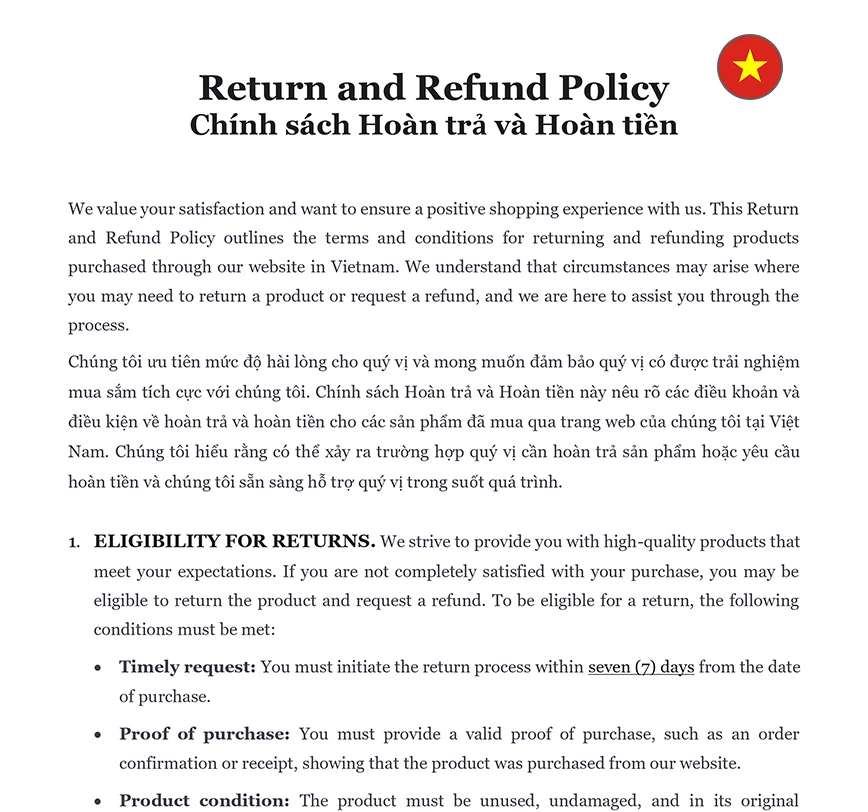Ready to use legal template
Drafted by experienced lawyers
Vietnamese-English translation
Ready to use legal template
Drafted by lawyers
Vietnamese-English translation
Home › Intellectual property › Return and Refund Policy
Learn more about Return and Refund Policy in Vietnam
In the dynamic landscape of e-commerce, a robust Return and Refund Policy is essential for fostering trust and clarity between businesses and consumers. Our meticulously crafted Return and Refund Policy template not only elucidates the rights and responsibilities pertaining to product returns and refunds but also ensures alignment with the legal framework in Vietnam. Developed by our team of adept lawyers well-versed in Vietnamese law, our template stands as a reliable resource for businesses seeking to navigate the complexities of consumer protection regulations. Presented in a convenient Word format, our templates offer flexibility and ease of customization, empowering businesses to tailor policies that resonate with their unique operational contexts while remaining compliant with the law.
Table of contents
What is a Return and Refund Policy?
What is included in a Return and Refund Policy?
Why is it important for businesses in Vietnam?
Are there any limitations to returns and refunds?
What is the process for initiating a return and refund?
Are there any regulations in different industries in Vietnam?
Are there exceptions to a business's obligation to offer returns or refunds?
What if I don’t have Return and Refund Policy?
What is a Return and Refund Policy?
A Return and Refund Policy, also known as a Refund Policy, is a crucial document that delineates the terms and conditions governing the return of purchased goods and the process for receiving refunds or exchanges. Serving as a contractual agreement between a seller and a buyer, this policy outlines the procedures, timelines, and any applicable restrictions regarding product returns. It typically covers various aspects such as eligibility criteria for returns, acceptable reasons for seeking refunds, and any associated fees or restocking charges. By clearly defining the parameters of the return and refund process, this policy helps establish transparency and accountability, fostering trust between businesses and consumers.
This document plays a vital role in managing customer expectations and reducing potential disputes by providing a clear framework for handling returns and refunds. It communicates important information regarding the rights and responsibilities of both parties, ensuring that customers understand the conditions under which they can seek redress for unsatisfactory purchases. Additionally, a well-crafted Return and Refund Policy can help businesses maintain compliance with legal requirements and industry standards, ultimately contributing to a positive shopping experience and enhancing brand reputation.
What is included in a Return and Refund Policy?
Here’s a list of common elements included in a Return and Refund Policy:
Introduction: An overview of the purpose and scope of the policy.
Eligibility: Criteria defining which products are eligible for return or refund.
Reasons for Returns: Specific circumstances under which returns are accepted (e.g., defective items, incorrect orders).
Timeframe: The window of time within which returns or refund requests must be made.
Conditions of Return: Any conditions or requirements that must be met for a return to be processed (e.g., items must be unused and in their original packaging).
Refund Process: Step-by-step instructions on how refunds are initiated and processed.
Exchange Policy: Details on whether exchanges are permitted and any associated procedures.
Restocking Fees: Information on whether restocking fees apply to returned items and under what conditions.
Shipping Costs: Clarification on who is responsible for covering shipping costs for returns.
Damaged or Defective Items: Procedures for handling returns of damaged or defective products.
Non-Returnable Items: List of items that are not eligible for return or refund (e.g., perishable goods, personalized items).
Exclusions: Any specific exclusions or limitations to the return and refund policy.
Policy Updates: Notification of any changes or updates to the Return and Refund Policy.
Legal Disclaimer: A disclaimer stating that the policy is subject to applicable laws and regulations.
These elements may vary depending on the nature of the business and the products or services offered.
Why is it important for businesses in Vietnam?
Having a clear and comprehensive Return and Refund Policy is crucial for businesses in Vietnam for several reasons:
| ➤ Legal Compliance: Ensuring that the Return and Refund Policy aligns with Vietnamese laws and regulations is essential. By clearly stating the terms and conditions of returns and refunds, businesses can avoid legal disputes and potential fines for non-compliance. |
| ➤ Consumer Trust: A transparent and fair Return and Refund Policy builds trust with customers. When consumers know what to expect in terms of returns and refunds, they are more likely to feel confident in making purchases from the business. |
| ➤ Customer Satisfaction: Providing a hassle-free return and refund process enhances customer satisfaction. Customers appreciate businesses that prioritize their needs and offer a straightforward mechanism for resolving issues with purchases. |
| ➤ Reduced Disputes: A well-defined policy helps minimize misunderstandings and disputes between businesses and customers. By outlining the eligibility criteria, conditions, and procedures for returns and refunds, businesses can mitigate conflicts and handle inquiries more efficiently. |
| ➤ Brand Reputation: A positive experience with the return and refund process can contribute to a positive brand reputation. Satisfied customers are more likely to recommend the business to others and become repeat buyers. |
| ➤ Competitive Advantage: A clear Return and Refund Policy can serve as a competitive advantage. Businesses that offer transparent and flexible policies may attract more customers compared to those with vague or restrictive policies. |




